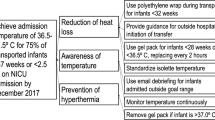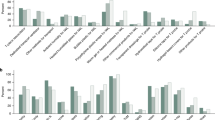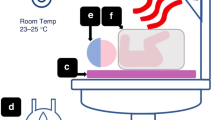Abstract
Background
We assessed the efficacy of Embrace Nest Infant Warmer versus Cloth Wrap in preventing hypothermia during short-term transport from the emergency department (ED) to the neonatal intensive care unit (NICU).
Methods
Neonates weighing ≥1500 g coming to the ED were randomized for transport to the NICU. Axillary temperature was measured.
Results
A total of 120 newborns (60 per group) were enrolled. From ED exit to NICU entry, the mean (SD) temperature increased in the Embrace group by 0.37 °C (0.54), whereas it reduced by 0.38 °C (0.80) in the Cloth group (p < 0.001). Hypothermia cases reduced in the Embrace group from 39 (65%) to 21 (35%), while it increased from 21 (35%) to 39 (65%) in the Cloth group (p = 0.001) from ED exit to NICU entry. The thermoregulation for 24 h after admission to the NICU was superior in the Embrace group.
Conclusions
Embrace showed significantly better thermoregulation in neonates. Further studies should be done to measure its effectiveness in different environments and distances.
This is a preview of subscription content, access via your institution
Access options
Subscribe to this journal
Receive 12 print issues and online access
$259.00 per year
only $21.58 per issue
Buy this article
- Purchase on Springer Link
- Instant access to full article PDF
Prices may be subject to local taxes which are calculated during checkout



Similar content being viewed by others
References
World Health Organization. Thermal protection of the newborn: a practical guide. Maternal and safe motherhood programme. 1997. p. 1–67.
Lunze K, Bloom DE, Jamison DT, Hamer DH. The global burden of neonatal hypothermia: systematic review of a major challenge for newborn survival. BMC Med. 2013;11:24.
Agarwal S, Sethi V, Srivastava K, Jha P, Baqui AH. Human touch to detect hypothermia in neonates in Indian slum dwellings. Indian J Pediatr. 2010;77:759–62.
Nimbalkar SM, Patel VK, Patel DV, Nimbalkar AS, Sethi A, Phatak A. Effect of early skin-to-skin contact following normal delivery on incidence of hypothermia in neonates more than 1800 g: randomized control trial. J Perinatol. 2014;34:364–8.
Million Death Study Collaborators. Causes of neonatal and child mortality in India: a nationally representative mortality survey. Lancet. 2010;376:1853–60.
Urubuto F, Agaba F, Choi J, Dusabimana R, Teteli R, Kumwami M, et al. Prevalence, risk factors and outcomes of neonatal hypothermia at admission at a tertiary neonatal unit, Kigali, Rwanda—a cross-sectional study. J Matern Fetal Neonatal Med. 2019;e-pub ahead of print 15 October 2019;1–8. https://doi.org/10.1080/14767058.2019.1671334.
Mullany LC, Katz J, Khatry SK, LeClerq SC, Darmstadt GL, Tielsch JM. Neonatal hypothermia and associated risk factors among newborns of southern Nepal. BMC Med. 2010;8:43.
Laptook AR, Salhab W, Bhaskar B, Neonatal Research Network. Admission temperature of low birth weight infants: predictors and associated morbidities. Pediatrics. 2007;119:e643–9.
Soll RF. Heat loss prevention in neonates. J Perinatol. 2008;28:S57–9.
Conde-Agudelo A, Díaz-Rossello JL. Kangaroo mother care to reduce morbidity and mortality in low birthweight infants. Cochrane Database Syst Rev. 2016 (8): CD002771.
McCall EM, Alderdice F, Halliday HL, Vohra S, Johnston L. Interventions to prevent hypothermia at birth in preterm and/or low birth weight infants. Cochrane Database Syst Rev. 2018:CD004210.
Embrace Innovations. https://www.embraceinnovations.com/. Accessed 5 March 2020.
Embrace—Design for Extreme Affordability. https://extreme.stanford.edu/projects/embrace/. Accessed 6 March 2020.
Satia J, Misra M, Arora R, Neogi S, editors. Innovations in maternal health: case studies from India. India: SAGE Publications; 2013.
How to use the Embrace Nest infant warmer. https://www.youtube.com/watch?v=8T_alDdmPyY. Accessed 9 March 2020.
Bhat SR, Meng NF, Kumar K, Nagesh KN, Kawale A, Bhutani VK. Keeping babies warm: a non-inferiority trial of a conductive thermal mattress. Arch Dis Child Fetal Neonatal Ed. 2015;100:309–12.
Nimbalkar S, Patel H, Dongara A, Patel DV, Bansal S. Usage of EMBRACETM in Gujarat, India: survey of paediatricians. Adv Prev Med. 2014;2014:1–5.
Nimbalkar SM, Khanna AK, Patel DV, Nimbalkar AS. Efficacy of polyethylene skin wrapping in preventing hypothermia in preterm neonates (<34 Weeks): a parallel group non-blinded randomized control trial. J Trop Pediatr. 2019;65:122–9.
Aylott M. The neonatal energy triangle. Part2: thermoregulatory and respiratory adaption. Paediatr Nurs. 2006;18:38–42.
Kumar V, Shearer JC, Kumar A, Darmstadt GL. Neonatal hypothermia in low resource settings: a review. J Perinatol. 2009;29:401–12.
Interprofessional Education and Research Committe. Newborn Thermoregulation. Champlain Matern Newborn Reg Progr. 2013. p. 1–16.
Baumgart S. Iatrogenic hyperthermia and hypothermia in the neonate. Clin Perinatol. 2008;35:183–97.
Darmstadt GL, Bhutta ZA, Cousens S, Adam T, Walker N, De Bernis L. Evidence-based, cost-effective interventions: How many newborn babies can we save? Lancet. 2005;365:977–88.
Musialik-Swietlińska E, Bober K, Swietliński J, Górny J, Krawczyk R, Owsianka-Podleśny T. Evaluation of sick neonates’ medical interventions in maternity units before transport to reference centres. Med Wieku Rozwojowego. 2011;15:84–90.
Chandrashekhar C, Doreswamy S, Nataraj N, Panachiyil G, Babu T. Transport of sick neonates to a tertiary care hospital: condition at arrival and outcomes. J Neonatol. 2019;33:283–4.
Rathod D, Adhisivam B, Bhat BV. Transport of sick neonates to a tertiary care hospital, South India: condition at arrival and outcome. Trop Doct. 2015;45:96–9.
Arora P, Bajaj M, Natarajan G, Arora NP, Kalra VK, Zidan M. et al. Impact of interhospital transport on the physiologic status of very low-birth-weight infants. Am J Perinatol. 2014;31:237–44.
Hodson WA. Temperature regulation. In: Gleason CA, Juul SE, editors. Avery’s diseases of the newborn.10th ed. Philadelphia, PA: Elsevier; 2018.
May L, Nshimyiryo A, Kubwimana M, Nahimana E, Schoen N, Gadgil A, et al. Performance of a nonelectric infant warmer in Rwandan health centers. Glob Pediatr Health. 2019;6:1-10. 2333794X19884820. https://doi.org/10.1177/2333794X19884820
Mekonnen AG, Yehualashet SS, Bayleyegn AD. The effects of kangaroo mother care on the time to breastfeeding initiation among preterm and LBW infants: a meta-analysis of published studies. Int Breastfeed J. 2019;14:12.
Buch PM, Makwana AM, Chudasama RK, Doshi SK. Status of newborn transport in periphery and risk factors of neonatal mortality among referred newborns. J Pharm Biomed Sci. 2012;16:1–6.
Bellini C, De Biasi M, Gente M, Ramenghi LA, Aufieri R, Minghetti D. et al. Rethinking the neonatal transport ground ambulance. Ital J Pediatr. 2019;45:1–7.
Meyer MP, Payton MJ, Salmon A, Hutchinson C, De Klerk A. A clinical comparison of radiant warmer and incubator care for preterm infants from birth to 1800 grams. Pediatrics. 2001;108:395–401.
Saluja S, Malviya M, Garg P, Gupta G, Jain N. Transport of a sick neonate. Evidence based clinical practice guidelines. India: National Neonatology Forum; 2010.
Oatley HK, Blencowe H, Lawn JE. The effect of coverings, including plastic bags and wraps, on mortality and morbidity in preterm and full-term neonates. J Perinatol. 2016;36:83–9.
Acknowledgements
Dr. Amee Amin, MD, from Charleston Area Medical Center/West Virginia University helped to check language.
Author information
Authors and Affiliations
Contributions
VAM and DVP conceptualized and designed the study, drafted the initial paper, reviewed and revised the paper. AGP designed the data collection instruments, collected data, carried out the initial analyses and reviewed and revised the paper. ASN and SMN conceptualized and designed the study, coordinated and supervised data collection, and critically reviewed the paper for important intellectual content. All authors approved the final paper as submitted and agree to be accountable for all aspects of the work.
Corresponding author
Ethics declarations
Conflict of interest
The authors declare that they have no conflict of interest.
Additional information
Publisher’s note Springer Nature remains neutral with regard to jurisdictional claims in published maps and institutional affiliations.
Rights and permissions
About this article
Cite this article
Morgaonkar, V.A., Patel, D.V., Phatak, A.G. et al. Embrace versus Cloth Wrap in preventing neonatal hypothermia during transport: a randomized trial. J Perinatol 41, 330–338 (2021). https://doi.org/10.1038/s41372-020-0734-x
Received:
Revised:
Accepted:
Published:
Issue Date:
DOI: https://doi.org/10.1038/s41372-020-0734-x
This article is cited by
-
Prognostic role of TOPS in ambulance-transferred neonates in a low-resource setting: a retrospective observational study
BMC Pregnancy and Childbirth (2022)



